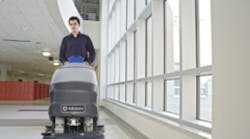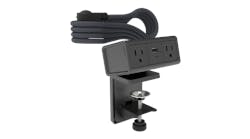Operations staffs at education facilities of all sizes are tasked with selecting a hard floor cleaning program that is cost-effective, efficient and highly productive. With an increased focus on the sustainability of an environment, facility managers also must select a program that meets sustainability goals while maintaining a healthful, safe environment for students and staff.
To meet these goals, many facility managers choose to carry out green cleaning processes, which includes transitioning to environmentally preferable equipment and green certified chemicals. Green cleaning initiatives are designed to help minimize environmental and human-health impacts, while maintaining or even improving the effectiveness of cleaning programs. In meeting their green cleaning initiatives, facility managers aim to reduce chemical, water and energy use, ensuring limited resource consumption and maintaining often-tight cleaning budgets. The underlying goal of a successful green cleaning program is to clean with less while improving cleaning effectiveness: fewer chemicals and pollutants, and lower water and energy usage.
Many facility managers are unsure of where to begin when considering a sustainable flooring for schools cleaning program. With an abundance of chemical, equipment and process solutions, it can be difficult to select and carry out a cleaning program that will satisfy green cleaning initiatives, while remaining cost-effective and efficient.
Getting Started
Green cleaning programs for flooring for schools employ practices that reduce environmental impact and bottom-line costs by minimizing water, chemical and energy use. The key to using fewer resources is being aware of how much water and chemicals are being dispensed into the waste stream. Before a green cleaning program is initiated, facility managers should measure and record their current cleaning costs, water and chemical usage. Once the green cleaning program is underway, costs and contributing factors should be measured and compared again with previous measurements to determine any changes in usage.
Although measurement is important to maintain budget resources, there are three major components of any green cleaning program: chemicals, equipment and processes and procedures. These components can significantly reduce the use of water and energy resources, and ensure the program is on track:
•Cleaning chemicals are used not only to remove tough soil buildup on floors, but also can be used to sanitize or disinfect floor surfaces. According to the International Facility Management Association, more than 6 billion pounds of cleaning chemicals are used each year in the performance of cleaning tasks. This level of chemical usage can result in significant environmental damage, and can lead to potential health and safety threats to those involved.
Several product-certifying organizations aim to reduce the environmental harm done by these substances, including Green Seal, EcoLogo and EPA Design for Environment. All of these certifying organizations provide approvals for cleaning products that perform well while protecting human health and minimizing toxic pollution and waste. Green cleaning programs nearly always mandate use of chemicals certified by one of these organizations.
•Equipment selection is another important factor in a facility’s green cleaning program. Leadership in Energy and Environmental Design for Existing Buildings: Operations and Maintenance (LEED-EBOM) sets the most specific equipment recommendations of any green cleaning standard. The LEED-EBOM IEQ credit 3.4 standard defines the specific attributes of floor equipment required for a green cleaning program, addressing equipment design, features, performance and noise levels.
A variety of cost-effective floor cleaning equipment can be selected for education facility cleaning applications to fit these cleaning requirements, including:
-Automatic scrubbers can clean hard-floor surfaces effectively, including hallways and classrooms, requiring minimal labor. Automatic scrubbers that meet LEED-EBOM requirements will have variable-speed feed pumps that allow for low-flow solution dispensing that will reduce chemical and water usage. Onboard chemical metering will optimize the use of cleaning chemicals, while still allowing for water-only cleaning. Automatic scrubbers developed today offer additional technology that assists facility managers in maintaining a flexible cleaning solution, enabling them to base water and chemical use on specific floor conditions.
-Multipurpose machines, such as a combination scrubber-extractor, are also an efficient equipment choice for flooring for schools, as they enable operators to use one machine instead of two. With the capability to perform multiple functions, such as scrubbing tough soils or extracting carpets, facility managers not only reduce the significant initial price tag of purchasing multiple machines for a building, but also reduce overall maintenance and operating costs. This also reduces a facility’s overall environmental impact, minimizing water and solution consumption.
-Alternative options include application-specific equipment. For example, burnishers are used to bring a high level of shine to finished floor surfaces, ensuring education facilities deliver a well-kept, clean appearance. Advanced models are designed for energy efficiency, operating quietly to eliminate disruption during daytime cleaning. Sweepers also can be used to provide maximum dust control in classrooms and hallways, enabling facilities to maintain healthy levels of indoor air quality for staff and students. For outdoor surface cleaning applications, such as sidewalks and grounds, outdoor cleaning equipment with the capability to reuse water reduces water consumption and aids EPA storm-water runoff compliance.
In addition to selecting floor cleaning equipment that meets LEED-EBOM recommendations, facility managers also can use equipment that offers superior flexibility in operating performance. Flexible cleaning technology enables operators to select the appropriate amount of water, detergent and down pressure used for various areas, and be able to change those settings on the fly.
For example, a water-only solution can be used to remove surface dirt and detergent residue, eliminating the use of chemicals entirely. Or, when the application requires a tougher solution, such as heavily trafficked entryways and hallways, operators can select the appropriate detergent cleaning solution. This capability lowers the costs and environmental impacts of using too much water and detergents, making certain that facility occupants aren’t exposed to excessive detergent while still ensuring that floors are cleaned properly.
No matter which type of floor cleaning equipment is selected, facility managers should employ an efficient piece of equipment that will reduce a facility’s overall environmental impact while maintaining high-quality cleaning performance.
•Green cleaning procedures. After selecting the appropriate floor cleaning chemicals and equipment, facility managers must define green cleaning procedures for their program. Regardless of how a facility identifies its desired level of clean; the floor-cleaning process is made up of four components:
-Time refers to the amount of time spent on certain areas. For example, a floor-scrubbing machine can be slowed down in order to spend more time on a soiled area. Green cleaning allows operators to significantly decrease time spent cleaning by limiting the need to "double-scrub" tough soils.
-Temperature: When the cleaning solution’s temperature is increased, the time required for chemicals to react with dirt is cut in half; conversely, as temperature decreases, reaction time increases.
-Agitation refers to the applied scrub pressure; more downward pressure on the brush means more agitation of detergent and water on dirty floors. Equipment that meets green cleaning requirements helps operators switch easily between various scrub pressures as needed.
-Cleaning substances include water and the various chemicals in detergents, sanitizers and disinfectants. In some green cleaning systems, the only cleaning substance used is water. Having a scrubber with a flexible cleaning solutions permits operators to switch between water-only and water/detergent cleaning.
Simmons is commercial product manager with Nilfisk-Advance, Plymouth, Minn. He can be reached at [email protected].



